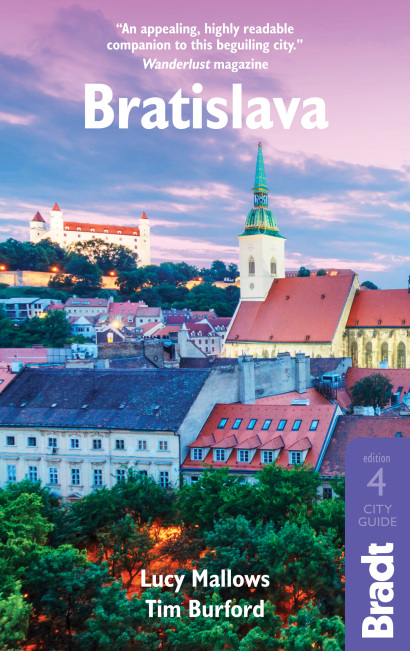Small, but perfectly formed and easily negotiated, Bratislava is the ideal weekend-break destination. The ‘Little Big City’ constantly regenerates and improves on its already spectacular setting and world-class facilities.
Lucy Mallows, author of Bratislava: the Bradt Guide
The legendary Casanova knew Bratislava and declared it ‘the most beautiful city in Europe’, and he knew a thing or two about beauty. Situated by the mighty Danube River and nestling in the Small Carpathian Mountains, Bratislava has a changing skyline: towering five-star hotels, shopping malls and apartment complexes now jostle for space in the suburbs surrounding the – thankfully – still historic Old Town buildings, churches and palaces. It is a good-looking capital filled with good-looking people who look like they’re enjoying life.
However, Bratislava never feels crowded despite the hordes of visitors who pack out the café terraces of the Mediterranean-style Old Town centre. There are many green regions to escape to: tree-lined squares, elegant parks and gardens and the verdant hills above the city.
Bratislava effortlessly blends history with hedonism. The world-class restaurants offer dishes prepared by talented local chefs, and they have been joined by a clutch of quality coffee houses, literary tea and bookshops, and many bistro-come-café venues where you can watch locals enjoying themselves over a home-made lemonade, hot chocolate, or quality Slovak wine or beer.
Bratislava’s small size is satisfying: it’s compact and visitor-friendly. You have the sense that you can discover everything in a few days, see all the important sights and get a real feel for the place. The many superbly-curated museums offer a glimpse into the turbulent history of Central Europe, and don’t forget the Opera House – Bratislava has two! Bratislava’s opera rivals those in Budapest and Vienna and the prices are astounding – €4 for a last-minute ticket is mind-blowing.
In short, Bratislava is the perfect destination for a weekend break, a romantic city break, a family holiday or as a base from where to discover the underrated attractions in the rest of Slovakia.
For more information, check out our guide to Bratislava
Food and drink in Slovakia
Food
Slovak cuisine is a mélange of central European influences, taking a bit of everything from its neighbours: goulash from the Magyars, strudels from the Austrians, and home-kneaded dumplings from the Germans – not to mention beer from the Czechs.
Slovak chefs grew up in the meat, potato and cabbage school of cooking; however, it’s easy to find something lighter in the many restaurants with international menus, offering cuisine from Italy to India, France to Vietnam. Many traditional Slovak restaurants also offer lighter versions of the sturdy, traditional dishes, and veganism is now widespread. Slovak cuisine is not as stodgy and bland as that in the Czech Republic and due to the culinary influence of southern neighbours, it has a perkier, spicier tang.
A hundred years ago, most Slovaks lived on and from the land and robust peasant cooking still dominates the national psyche. This is the land of cabbage, caraway seeds, cheese, wheat flour, potatoes and endless variations on the theme of pork. However, after a day cycling along the Small Carpathian Wine Route or visiting castle ruins, such hearty fare can be just the thing.
After 1,000 years under Hungarian domination and 40 years of communism, Slovakia’s restaurant culture remains in its infancy, although in Bratislava they have caught on quickly with new, exciting restaurants opening every month. Many restaurants place copies of the menu by the front door on the outside wall, so you can get an idea of the food and the prices before you venture in. This is not compulsory, but because of a ‘good local habit’ to be helpful. It also gives restaurants the chance of showing their wares in the hope of tempting visitors to enter.
All restaurants in Bratislava are required by law to issue a printed receipt from the electronic cash register, so if you have any concerns over the bill, make sure you get one. Major credit cards are usually accepted, but check first, before launching into the chateaubriand steak for two and champagne supper.
Bratislava Old Town is a wall-to-wall eat-out city with cafés, bars, cocktail venues, restaurants, self-service canteens, stand-up buffet stalls – you’re totally spoilt. Slovak, international, Mediterranean, Mexican, Japanese – there’s a great choice and it’s doubtful that you’ll need to book (apart from at the ‘flavour of the month’), as if your intended eaterie is full, just totter two yards along the pavement and you’ll find another option.
Drinks
Slovak mineral water (minerálna voda) is delicious and contains many lifeenhancing properties. Also popular are soft drinks like Kofola (Czech cola) that’s mixed with soda water and often available on draught in half-litre mugs. Vinea is a refreshing red or white grape juice drink sold in tall glass bottles and local fruit juices are excellent, with unusual choices like peach, pear or lip-puckering quince.
These days, the most popular drink served in Bratislava is homemade lemonade. It often arrives in a jam jar, half-litre jug or some other funky glass and will have added orange zest, ginger, nettles, cucumber, watermelon, lavender, cardamom, elderflower, rose petals, mint and stevia, or something else that the bartender has dreamed up that week. This is a delicious alternative to beer, especially in the often-overpowering heat of a summer’s day.
For centuries under Hungarian rule, the peasant population had little access to wine (vino), which went to nobles throughout the kingdom, although the lower-quality stuff did serve as an everyday drink in wineproducing areas. Beer (pivo), the beverage of the rising burgher class, cost too much for most peasants and it was illegal to make it without a royal licence. Burčiak is a young wine, cloudy and still fermenting, which is produced in September, doesn’t last long and can explode in the bottle. Try it at the Pezinok and Modra wine festivals.
Slovaks used to distil at home the produce from their orchards, creating the famous, fiery plum brandy (slivovica), and similar paint-stripping brews from pears (hruškovica), cherries (čerešňovica), apricots (marhuľovica) and even beetroot (repovica). Devín specialises in a less fiery currant wine (ríbezlák). Borovička is made from juniper berries and tastes a bit like gin. It’s said to be the best cure for a cold. Demänovka is another bittersweet herbal liqueur while the cinnamony Becherovka is Czech but also worth a try.
Honey wine (medovina) used to be made in nearly every village home. This custom has dwindled nowadays, but most villages still have at least one beekeeper. This mead-like drink is still served hot at Bratislava Christmas market and there is another bizarre festive drink which the brave can try there. Hriatõ is an alcoholic ‘speciality’ made from heated honey and bacon or goose fat, giving off a powerful aroma. It makes a good cough mixture, if you can get it down.
Health and safety in Slovakia
Health
The standard of public health in Slovakia is very good. The tap water is perfectly drinkable, but cheap and beneficial mineral water is also available in shops, cafés, restaurants and hotel minibars (€0.75–1 for a 1.5-litre bottle in shops).
No vaccinations are legally required but it is wise to be up to date with routine vaccinations such as diphtheria, tetanus and polio. This is now given as an all-in-one vaccine (Revaxis) which lasts for ten years. Hepatitis A should also be considered. For those who are going to be working in hospitals or in close contact with children, hepatitis B vaccination is recommended. The course comprises three vaccines over a minimum of 21 days. Rabid deer and foxes roam the Slovak countryside so pre-exposure rabies vaccine (ideally three doses given over a minimum of 21 days) should also be considered for anyone who is going to be working with animals. If you are unfortunate enough to be bitten, scratched or licked over an open wound you should scrub the wound with soap under running water and apply an antiseptic. You should then get to medical help as soon as possible for treatment. Tell the doctor if you have had the pre-exposure course of vaccine as this will change the treatment you need and make it more available in Slovakia.
The sun is very strong in central Europe; this is because the air is still relatively clean as there is not a lot of heavy industry or traffic congestion. Take a supply of suntan lotion and after-sun care, or look in the local shopping mall.
Many people smoke and the concept of non-smoking areas in restaurants has been slow to catch on.
The cuisine can be heavy on the meat and fat, and locals have already joined the world trend towards obesity. Cases of bovine spongiform encephalopathy (mad cow disease) have been reported in cattle in Slovakia. To avoid risk don’t try the often-offered beef tartare, which involves raw meat spread on toast. Alcoholism is not as widespread as in neighbouring countries, but with the availability of powerful, cheap spirits, it’s sensible to watch your intake.
Cases of the H5N8 ‘bird flu’ virus have been detected in wild birds and hens in Slovakia from time to time since 2016; this has never transferred to humans, but birds are culled and protection zones set up following standard EU practice.
People don’t swim in the Danube because of the strong current and pollution, but there are many local lakes where the water is pretty clean (Zlaté Piesky, Senec and Kuchajda Lake in the Nové Mesto district, for example). Mosquitoes are irritating and the Danube in summer is plagued by the little devils. If you stay on a botel (hotel on a boat), take a good supply of insect repellent and cream.
If you intend to go walking or cycling in the countryside remember that a tick bite can cause the potentially deadly disease encephalitis. TBE (tickborne encephalitis) is now endemic in 16 European countries, including Slovakia, Austria and Hungary.
The disease is most prevalent during the warmer spring, summer and autumn months when the ticks are active. Vaccination against tick-borne encephalitis is readily available in the UK and two injections given at least two weeks apart are needed, with a third dose given five to 12 months later if at continued risk. Ticovac is available for adults and children aged one and above. Whether you are immunised or not, you should make sure that you wear suitable clothing, such as a hat and long trousers tucked into boots, and use tick repellents.
Ticks should ideally be removed complete, and as soon as possible, to reduce the chance of infection. You can use special tick tweezers, which can be bought in good travel shops, or failing this your finger nails, grasping the tick as close to your body as possible, and pulling it away steadily and firmly at right angles to your skin without jerking or twisting.
Irritants (eg: Olbas oil) or lit cigarettes are to be discouraged since they can cause the ticks to regurgitate and therefore increase the risk of disease. Once the tick is removed, if possible douse the wound with alcohol (any spirit will do), soap and water, or iodine. If you are travelling with small children, remember to check their heads, and particularly behind the ears, for ticks. Spreading redness around the bite and/or fever and/or aching joints after a tick bite imply that you have an infection that requires antibiotic treatment. In this case seek medical advice.
Safety in Slovakia
Crime
Bratislava is a safe city for travellers, with a low rate of violent crime. There is, however, a high incidence of petty theft. Pickpockets operate around the main tourist areas, the railway station and in large shopping malls and foreigners are easily identified and targeted. Cameras, mobile phones and small electrical items (computers, games, etc) are as attractive as cash and credit cards. Take sensible precautions against bagsnatching and mugging. Do not leave valuables unattended or anything on show in a hire car.
You will see quite a lot of homeless people in Bratislava, sitting outside Tesco on Kamenné námestie, on Námestie SNP and on Hviezdoslavovo námestie. They are harmless, drinking cheap wine and look too tired to hassle tourists, although I saw one tall homeless man picking on a little Roma lad who always stands outside McDonald’s.
You must carry your passport with you at all times as identification. Keep it safe, in a zipped-up pocket or secure bag and keep a photocopy of the details separately in case you lose it. Contact your embassy in Bratislava immediately if you do lose your passport.
Check restaurant bills; restaurants are legally required to provide a receipt from the electronic till. Taxi drivers have an undeserved reputation for ripping off foreigners. I have taken countless taxis in Bratislava and, with one unfortunate exception, they have been inexpensive and the drivers charming and helpful.
Taking photographs of anything that could be perceived as a military establishment or somehow of security interest used to be a problem but everyone’s much more relaxed now. When driving, remember there is a zero tolerance of alcohol and hand-held mobile phone use when driving is also illegal. There are spot fines for speeding or drinking.
When walking around late at night, avoid the stations or deserted parts of town; however, the Old Town is perfectly safe at all times. Travellers with darker skin colour should be aware that there is a nasty rash of nationalist skinheads in parts of Slovakia. They tend to be ‘nerds’ who focus on what they see as historical injustices but they would not be pleasant to encounter in a dark alley.
Female travellers
Slovak men are courteous, if a little old-fashioned regarding women. Feminism is still a fairly new concept here, and women on their own are more likely to be pitied than pestered.
LGBTQ+ travellers
Similarly to its former ‘Eastern Bloc’ neighbours, Slovakia lags behind western Europe in terms of gay rights and attitudes to LGBT+ people. Slovaks are quite conservative and, while not overtly homophobic or aggressive, they would not appreciate kissing, handholding or other public displays of affection between same-sex couples. Discretion is advised.
Travelling with children
Slovaks adore children and Bratislava is a very safe destination for travellers with young ones. The city is packed with many child-friendly venues such as playgrounds, parks (page 180) and Bratislava Zoo/DinoPark. British visitors might be surprised to see adults giving up their seat on the tram for a perfectly healthy five-year-old.
Travel and visas in Slovakia
Visas
In 2007, Slovakia joined the then 15-member Schengen Zone, abolishing border controls among participating countries. After entering the Schengen Zone, visitors may travel throughout the now 28-member zone without any other passport or visa control; however, they must be able to prove their visa status on request.
Slovakia now has only five actual border posts (with Ukraine) and three air borders, at Bratislava, Košice and Poprad airports.
All visitors to Slovakia need a valid passport for the duration of their stay in the country or, if a visa is required, visitors must present a passport with more than three months left till the date of expiry. Citizens from EU member countries and Switzerland can enter Slovakia with just a valid national identity card (where the country concerned issues such cards).
British nationals may visit Slovakia with a valid passport for a period of up to 180 days, while the other EU countries’ citizens may stay in the country for up to 90 days. Nationals from 40 countries worldwide, including Australia, Brazil, Canada, Croatia, Israel, Japan, Malaysia, Mexico, South Korea, Malaysia, New Zealand and the USA, may also stay in Slovakia with a valid passport for up to 90 days out of any 180-day period. After the UK leaves the European Union, documentation requirements for UK citizens may change. Check before travelling.
Nationals from all other countries require a visa and should contact the Embassy of the Slovak Republic in their home country before setting off. Click here for details of current visa requirements.
Getting there and away
By air
Travellers to Bratislava are lucky as they have a choice of two airports – Bratislava and Vienna Schwechat (only 61km away) – giving more variety of route, cost, timing and budget flight possibilities. Ticket prices will be higher during peak summer season (June–August) and at Christmas and New Year.
Discount travel websites such as Cheapflights, Expedia and lastminute.com can offer bargain flights.
By train
If you don’t fancy flying, or want to stop off en route, try the train. First cross the Channel by Eurostar to Brussels, take the high-speed Thalys to Köln (Cologne), then the Nightjet sleeper to Wien (Vienna). Slovak State Railways and The Man in Seat 61 have information in English about train connections. You’ll arrive at Bratislava’s bustling main station, Hlavná stanica.
By bus
It is possible to travel to Bratislava by bus/coach from all major European cities; Eurolines is the most widely used company.
Bratislava’s main bus station is at Mlynské nivy 31. It’s a 15-minute walk from the bus station to the Old Town centre, but too far to walk with luggage. Taxis will whisk you into town, or take trolleybus 202 or 208 to Hodžovo námestie, trolleybus 210 to the main railway station or bus 50 to Most SNP. The bus station was closed at the time of writing for redevelopment until 2020, but a more than adequate substitute (with free toilets) has been provided across the road to the south.
The national bus company, Slovak Lines, offers tickets, travelcards and timetables, for destinations within Slovakia. RegioJet, Slovak Lines and Flixbus run buses roughly hourly via Vienna Airport to central Vienna (from £6 in advance). In addition, FlixBus and RegioJet both run twice a day to Budapest city and airport (4hrs).
By car
It is about 1,500km by road from London to Bratislava and the journey would take at least 17 hours. The route, once on the continent, goes via Brussels, Aachen, Köln (Cologne), Frankfurt and Linz.
You need to buy an e-vignette to use Slovak motorways (from €10 for ten days; windscreen stickers are no longer used). You’ll also need a vignette to cross Austria (€9.20) – best bought from a service station as you approach the border.
By boat
International connections from Austria and Hungary are possible on the Danube, which also carries passing barges and cruises heading for the Rhine, the Main and the Black Sea. Two companies, LOD and Twin City Liner, offer high-speed river services between Vienna and Bratislava, one leaving Vienna in the morning and one leaving Bratislava in the morning, for those planning a day trip.
Getting around
The transport system is impressively well organised with buses, trams, trolleys and trains all linked up in the new Bratislava Integrated Transport (BID) system, with a unified zonal fare structure. Vehicles are comfortable and clean, real-time information is displayed at stops (although services generally run on time) and prices are low. On all methods of transport, most stops are request only, so you’ll probably need to ring the bell to get off. The Bratislava Transport Company website can be found here, but for timetables and a route planner in English, plus a brief history of the city’s transport, you’re best off clicking here.
Trams
There are nine tram routes running all around town, numbered 1–9. The trams generally run between 05.00 and 23.00 (route 7 only runs 06.00–09.00 Mon–Fri).
Buses
There are 64 bus routes, numbered 20–196 (with numerous missing numbers), one express bus (the X72 east to Ružinov) and 20 night-bus routes (see below). Buses run generally between 05.00 and 23.30 and all link up well with the trams and trolleys, and services run on time. Probably the bus route you will use the most is the 29 (plus 129 at weekends) to Devín.
There are 20 night buses, numbered from N21 to N99, with a lot of missing numbers. Buses run between 23.00 and 03.30 and link the city centre, the main railway station and many of the outer suburbs such as Rača, Čunovo and Devínska Nová Ves. Hodžovo námestie, with the president’s Grassalkovich Palace on one side and the Crowne Plaza Hotel on the other, is something of a night-bus hub, with eight routes meeting here. The most useful are the N33, which runs from the main railway station through the town and west by the river; the N61, from the station through the centre to the airport; and the N93, from the station through town to Petržalka.
Trolleybuses
There are 13 trolleybus routes, numbered from 201 to 212 (at the time this guide went to print there was no number 206), plus 33 and 64 (which use a diesel engine off the wires), running mostly in the hills and northern parts of town. Trolleys run generally between 04.00 and 23.00 and can also go around in a loop and come back on a different route from the way you went.
Bike
Bratislava is gripped by a cycling craze with new cycle routes appearing regularly and trendy bike shops popping up around town. The new Slovnaft Bajk bike-sharing system is very popular and easy to sign up to. In fact, the Old Town, once a haven for pedestrians and tiddly, tottering stags, is now much more hectic with silent bikes and Segways whooshing past.
Both banks of the Danube have cycle routes and it is possible to cycle to Devín. However, the direct road along the river is busy and narrow in places (and cycle lanes can’t be added because it’s a protected area) – you might prefer the hilly tracks through the forest inland or to take a train to Devínska Nová Ves and cycle south from there along the excellent Morava Valley route. There’s also the Stefanikova Cyklomagistrala, a ridge route along the hills north from Kamzík.
Taxis
Some say local taxi drivers are a brat pack, who rip off foreigners at every possible occasion. There may be some truth in this at the airport and main rail and bus stations, but mostly the drivers are courteous, extremely friendly and helpful. App-based services such as Uber have been permitted in Bratislava since April 2019. Taxis around the city should cost €6–12, while from the city to the airport it is €20–25. From the city to Vienna Airport costs €60–65.
Car hire
As the city centre is car-free and the public transport system is excellent, you only really need to hire a car if you’re looking to explore the surrounding region, or visit Košice. Slovak car-hire agencies are substantially cheaper than those of Western firms, ranging from €23 to €50 per day, and the process is marked by much less red tape. There are many car-hire companies at M R Štefánik Airport.
When to visit Slovakia
Slovakia achieved independence only in 1993 and, as one of Europe’s youngest capitals, Bratislava is also one of its most progressive. There’s never been a better time to visit.
It takes only 2½ hours to fly there from London, while on the ground it is an hour from Vienna, two from Budapest and three from Prague. The ‘little big city’ is a strategic hot-spot with a leisure industry to match.
Spring and summer in Bratislava can be really gorgeous. Come during April and you’ll probably have the place to yourself, apart from the occasional stag party (easily identified and avoided by their matching T-shirts proudly announcing ‘Gary’s Gang’ or ‘Plastered in Blava’), but the weather can be glorious. At the end of the month, out come all the terrace tables and chairs outside the pubs, restaurants and cafés, turning the Old Town into ‘one big open-air café’.
In the height of summer, the River Danube moderates the heat and there are many green spaces such as Devín and the Kamzík Hills to escape to, countless lakes to cool off in (the nearest being Zlaté Piesky, a tram-ride away), and scores of leafy squares.
The autumn colours are beautiful. There are many parks in town and it is still warm enough to sit outside a café and contemplate the historic scenery. Winter is also atmospheric, with the snow, the Christmas markets and the hills nearby if you want to ski or hike. Do bear in mind that some museums and castles such as Devín may be closed during this season, and shops and bars also have limited opening hours.
Climate
Slovakia’s climate is temperate with warm, wet summers and cold, hard winters. Bratislava is located in a mild climatic zone of continental nature, characterised by wide differences between temperatures in summer and winter and, until recently, by four distinct seasons. Average temperatures in Bratislava for winter are -1–4°C (30–40°F), spring and autumn 9–21°C (49–69°F) and summer 24–26°C (75–79°F), although over the last decade spring and autumn have merged into the more dramatic seasons, meaning that spring, usually a delightful season in the Old Town, has sadly almost disappeared.
The average annual temperature in the Bratislava region has risen by almost 2°C since 1951 and will keep increasing, bringing hotter, drier summers. Snow cover on the mountains in the north is less than it has been in the past. The lowest annual temperature is in the mountains at Lomnický štít (peak) (-3.7°C). The warmest zone is the Podunajská Lowland (10.3°C).
What to see and do in Slovakia
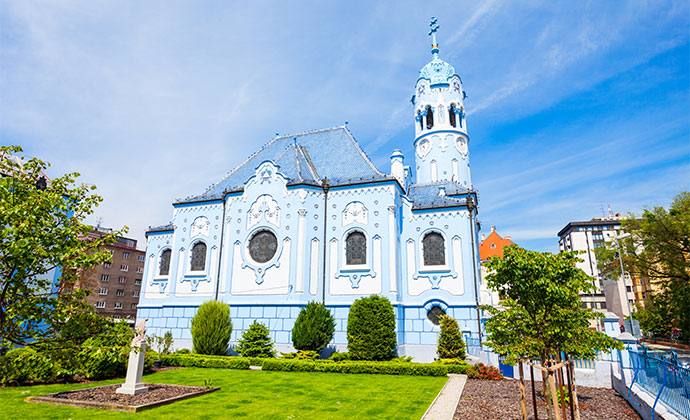
Blue Church
The full title is the Church of St Elizabeth (Kostol sv Alžbety). According to legend, Elizabeth, the daughter of Endre II of Hungary, was born in Bratislava in 1207 and was the city’s only well-known saint. It was decided that a church be built in her honour and permission was asked from the Hungarian archbishop Vászáry.
The Hungarian architect and ‘father of Hungarian Art Nouveau’ Ödön Lechner was commissioned to design a church in 1907, on the 700th anniversary of Elizabeth’s birth, while Antal Durvay was in charge of the construction work. Lechner used concrete for the church and covered the exterior with plaster painted in several shades of blue, decorated with ceramic floral tiles in darker blue. He knew the legend of St Elizabeth well and used her rose motif many times in the decoration. Budapest painter Gyula Tury decorated the altar showing Elizabeth giving alms to the poor outside Wartburg Castle. The church was consecrated on 11 October 1913.
Note that the church’s opening hours are awkward and unreliable, especially in winter; you can at least look through the glass doors and it should be open for half an hour before the daily 18.00 service.
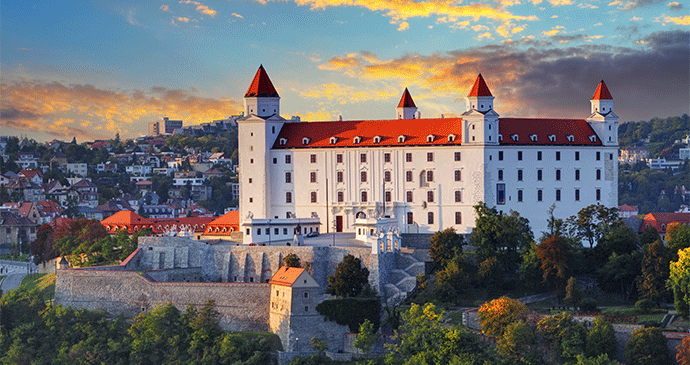
Bratislava Castle
In A Time of Gifts, Patrick Leigh Fermor wrote that ‘the symmetry of the huge gaunt castle and the height of its corner towers gave it the look of an upside-down table’ (although he saw it before it was restored and painted white as today). Also described somewhat cruelly as an ‘upsidedown bedstead’, the present Bratislava Castle was constructed in 1430 by King Sigismund of Luxembourg.
There had been previous fortifications on the hill, rising 85m above the Danube, built first by Celts then Romans then in the 9th century by the Slavs. The conquering Magyars also built fortifications on the hill and there was extensive construction work in the 13th century. King Sigismund reconstructed the castle and added outer defence walls, some 11m thick, and the Habsburgs used the castle as protection against the Turks, the Hungarian Crown Jewels being kept there from 1552. Its trademark four corner towers were added between 1635 and 1649 when the Hungarian Viceroy Pál Pálffy called in Giovanni Battista Carlone to help with a redesign.
Maria Theresa called it ‘her castle’ and converted it into a grand palace in 1761, when the interior was redesigned in a lavish Rococo style and a number of annexes were added to the north and west. It became the residence of her favourite daughter Maria Cristina and her husband, Archduke Albert of Saxony-Teschen, who was Governor of Hungary from 1765 to 1781 (the story goes that she was the only one of Maria Theresa’s daughters allowed to marry for love, the others being married off for diplomatic purposes). He was a great art collector but unfortunately his paintings didn’t remain here but instead became the basis of the fabulous Albertina Museum in Vienna.
In any case, Maria Theresa’s successors did not share her love for Bratislava and the castle, and it fell into disrepair: it was used for a while as a seminary and a barracks, and in 1811 it burnt down in a devastating fire and remained in ruin for 140 years until restoration work began in 1953. Today it houses exhibitions for the Slovak National Museum as well as state rooms of the Slovak National Council. Most recently, the Winter Riding Hall and the Baroque gardens on the castle’s north side have been restored to their 1780 condition (though with a new underground car park beneath).
The castle, with its huge courtyard, is an imposing and atmospheric building and the tree-studded grounds perched on the hill offer a lovely place for a stroll or a picnic with a view over the Old Town and Petržalka. There are a couple of restaurants within the castle area too; the upmarket Hradná Hviezda and the Reštaurácia Hrad with a great terrace overlooking the city and the Danube.
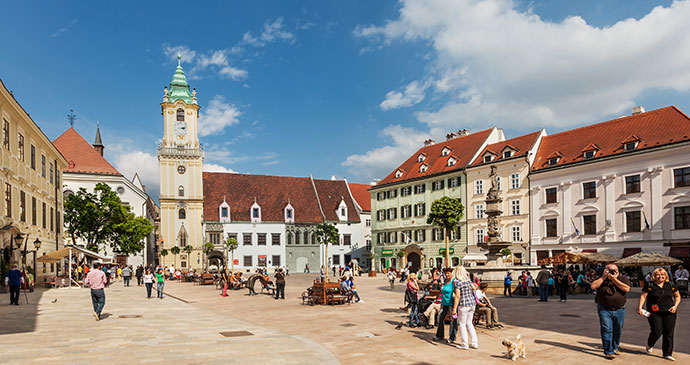
Hlavné námestie
You’ll find everything on the Main Square: three great cafés, Art Nouveau buildings, the Roland Fountain, and statues of Schöne Naci, a guardsman and a Napoleonic soldier.
The square originated in the 13th century and, from the start, was at the centre of the town’s social life – a place of markets, festivities and executions – all well attended. Hlavné námestie is almost indistinguishable from Františkánske námestie (Square of the Franciscans) immediately north where there are little stalls with people selling folky souvenirs and an excellent Christmas market.
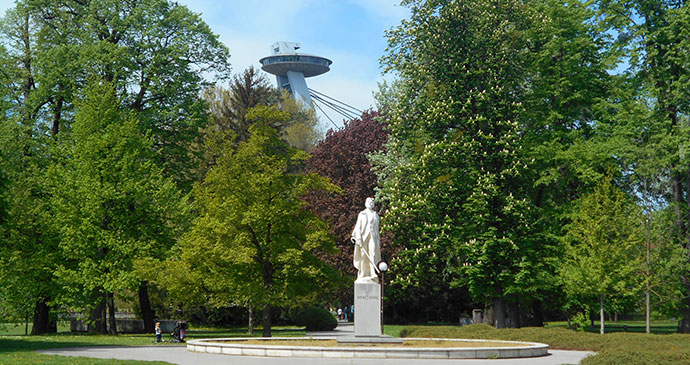
Sad Janka Kráľa
South of the Danube, this park seems like the first choice for those seeking a patch of green. The park was created in the time of Maria Theresa, and the eponymous Janko Kráľ (1822–76) was a revolutionary poet who used to walk there. There are several restaurants in the park and features of interest such as a 14th-century Franciscan church tower that used to stand in the Old Town but was removed from the church and brought to the park in 1897.
A plaque near the Einsteinova main road reveals that an ‘anti-Napoleonic wall’ stood here in 1809. The park is also decorated with 12 astrological star signs marked out along the circular pathway with a symbol and a collection of benches to have a rest on; it’s fun trying to find your sign. The ground-breaking Aréna Theatre stands by the water near the Old Bridge. For mall rats, it’s a pleasant stroll across the Most SNP and through this park to reach Aupark shopping centre.
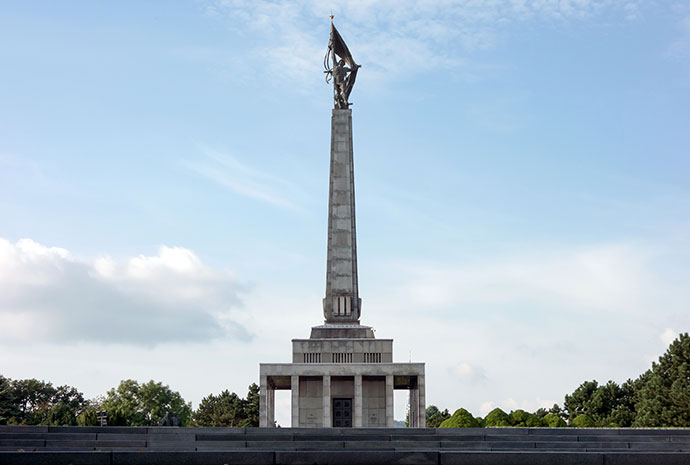
Slavín Monument
In a well-to-do part of town (home to ambassadors and the like), just northwest of the centre, Slavín Hill is crowned with a monumental Soviet war memorial (chief architect Ján Svetlík, 1960) to the 6,845 Red Army soldiers who lost their lives in the battle for Bratislava (spring 1945) and are buried here in six mass graves and 317 individual graves.
A 37m-tall column by Tibor Bártfay (creator of the Peace/World globe statue in front of Grassalkovich Palace) has a 7m soldier raising a flag and crushing a swastika; a gold star on the top was created by the Slovak Alexander Trizuljak. Around the base of the monument are the names of Slovak towns and the dates they were ‘liberated’ by the Red Army. At one side there is a peace garden of eight white poles, instigated by Alexander Dubček.
From here, there is a great view of the city and it seems huge with many more skyscrapers and tower blocks than other cities in the region. It’s easy to find the monument as Slavín is visible from all parts of town – just head off uphill through a district of villas with interesting architectural styles.
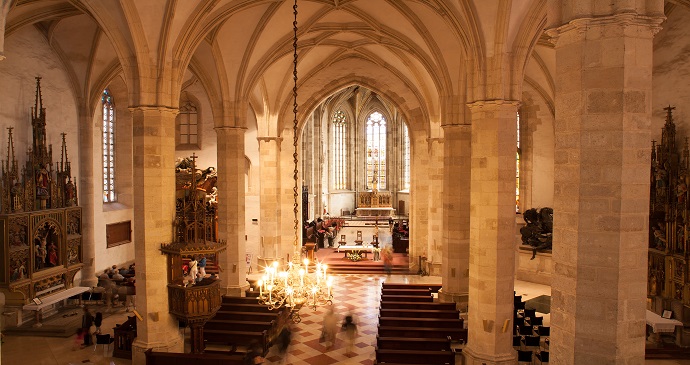
St Martin’s Cathedral
Construction of this triple-naved church lasted from 1311 to 1452. Between 1563 and 1830 it was the coronation church for the kings of Hungary and witnessed the crowning of 11 Hungarian kings and eight royal spouses. The tower is 85m tall, topped with a 150kg gilded model of the crown of Szent István (St Stephen), the first king of Hungary (in AD1000).
The late Gothic vaulting is by Hans Puchspaum under direct influence of master masons from Vienna. In 1728 the Archbishop of Esztergom, Emeric Esterházy, invited a famous Austrian sculptor, Georg Rafael Donner, to Bratislava to establish a workshop and he stayed 11 years creating many masterpieces for the city.
From 1732 to 1734 he built the chapel of St John the Almsgiver, in the north aisle with the kneeling figure of the archbishop, and in 1734 he created a new high altar featuring a huge equestrian statue of St Martin and the Beggar, which now stands in the southeast corner of the nave of St Martin’s Cathedral – the figure of St Martin was supposedly modelled on the archbishop and the beggar on Donner himself.
The first complete performance of Beethoven’s Missa Solemnis took place here in 1830, and Franz Liszt conducted his Coronation Mass here in 1884.
From April to mid-November you can pay €2.50 to visit the Treasury; there are various fine religious objects on display, but you also get the view from the organ gallery at the west end.
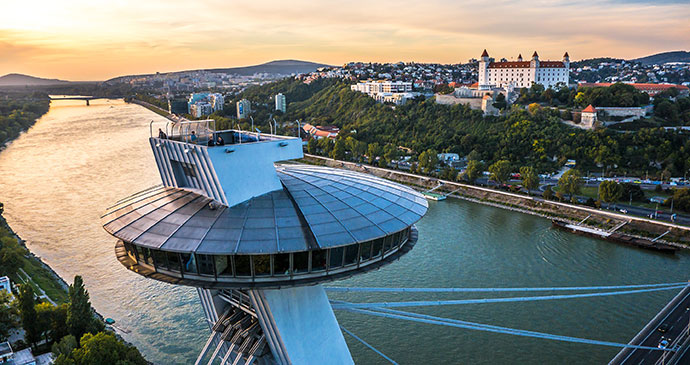
UFO Tower
The UFO hovers 80m above the Most SNP (Slovenské národné povstanie or Bridge of the Slovak National Uprising) and offers an unparalleled view of the city. The bridge and UFO were built in 1967–72 and declared ‘Building of the Century’ in Slovakia in 2001. The asymmetrical structure has a main span length of 303m, and the unique attraction is the flying-saucer-shaped object housing a restaurant, bar and lookout platform above.
The UFO restaurant, previously called Bystrica, perches on top of the bridge’s 84.6m sloping pylon. The viewing platform above the restaurant offers stunning views over the Danube, the Old Town and the Petržalka district. The east pillar has a lift, while the west pillar houses an emergency staircase with 430 steps.
Related books
For more information, see our guide to Bratislava:
Related articles
Nothing found.
